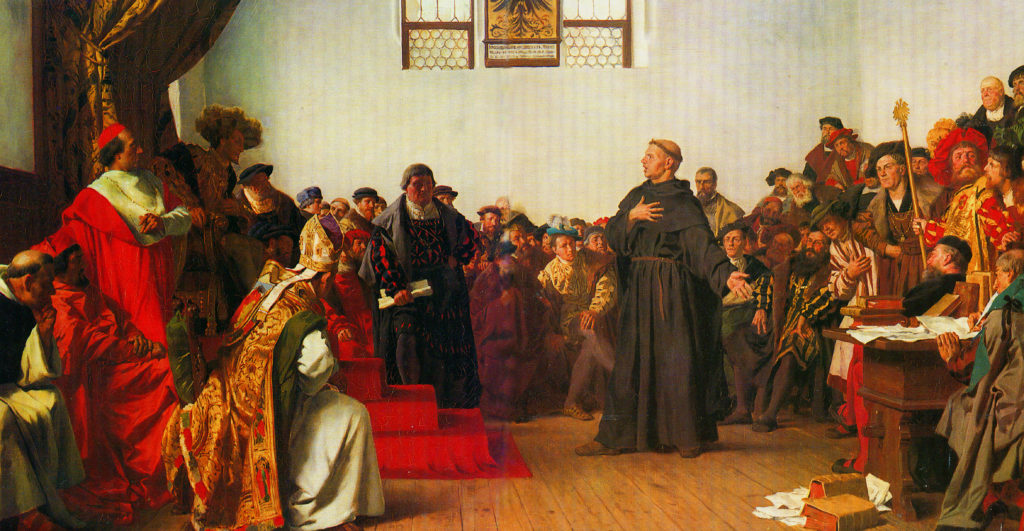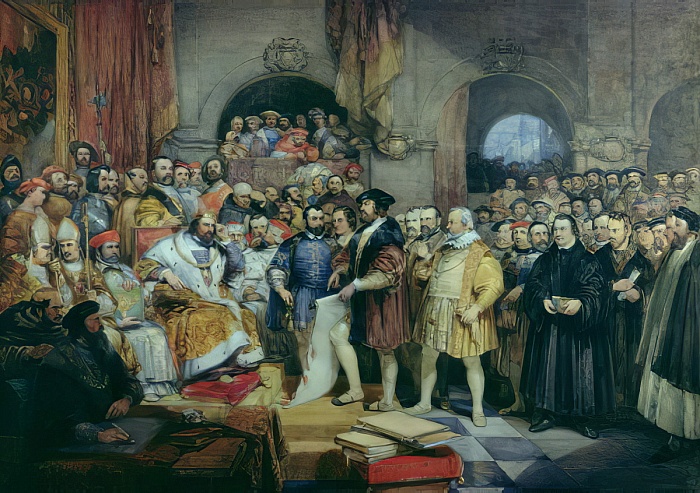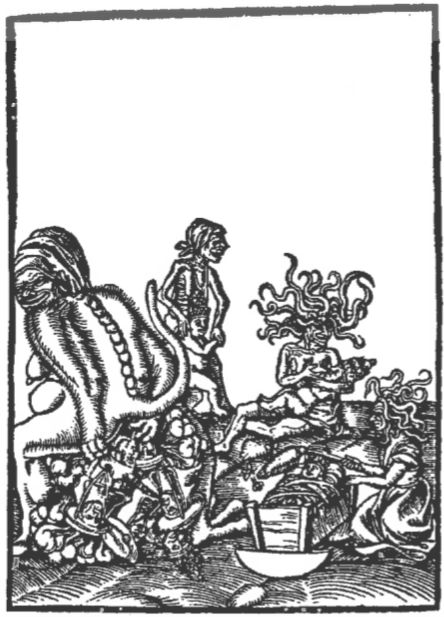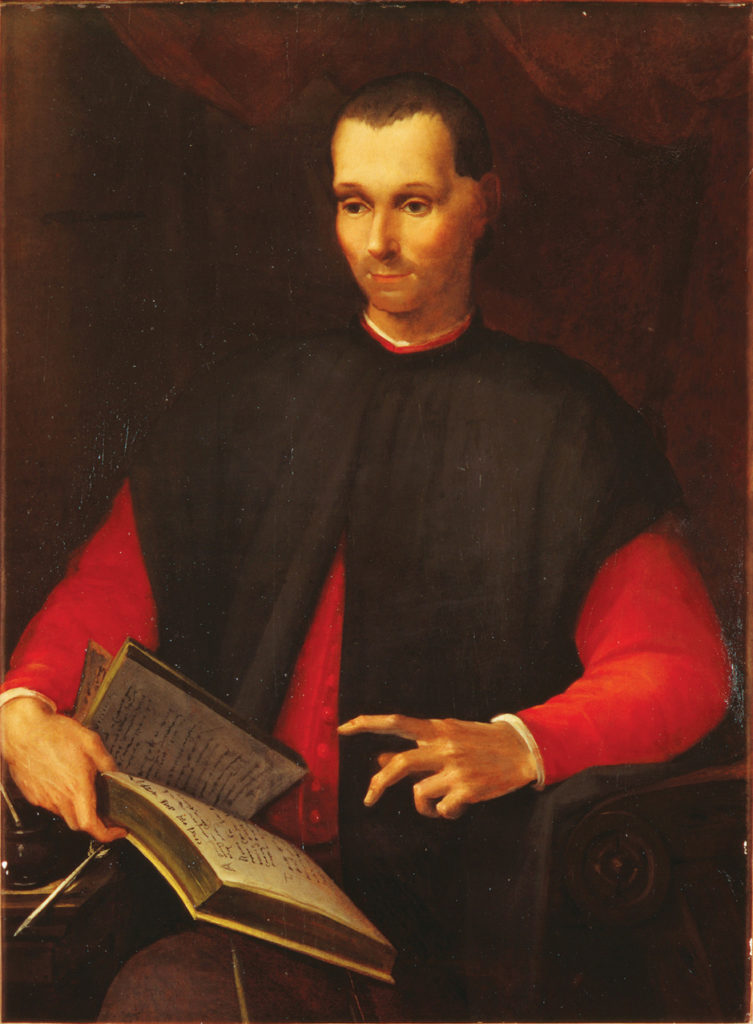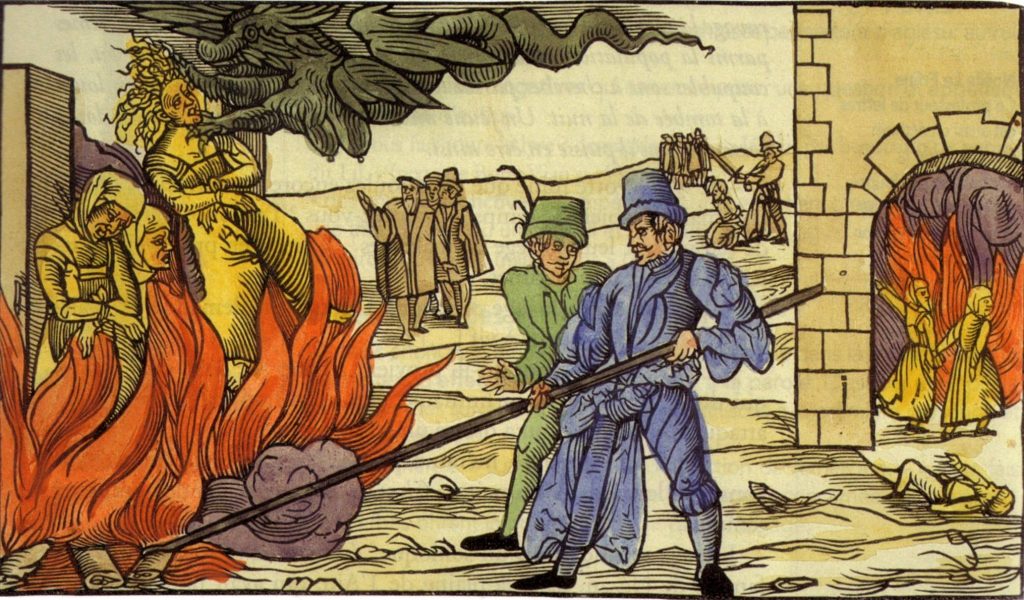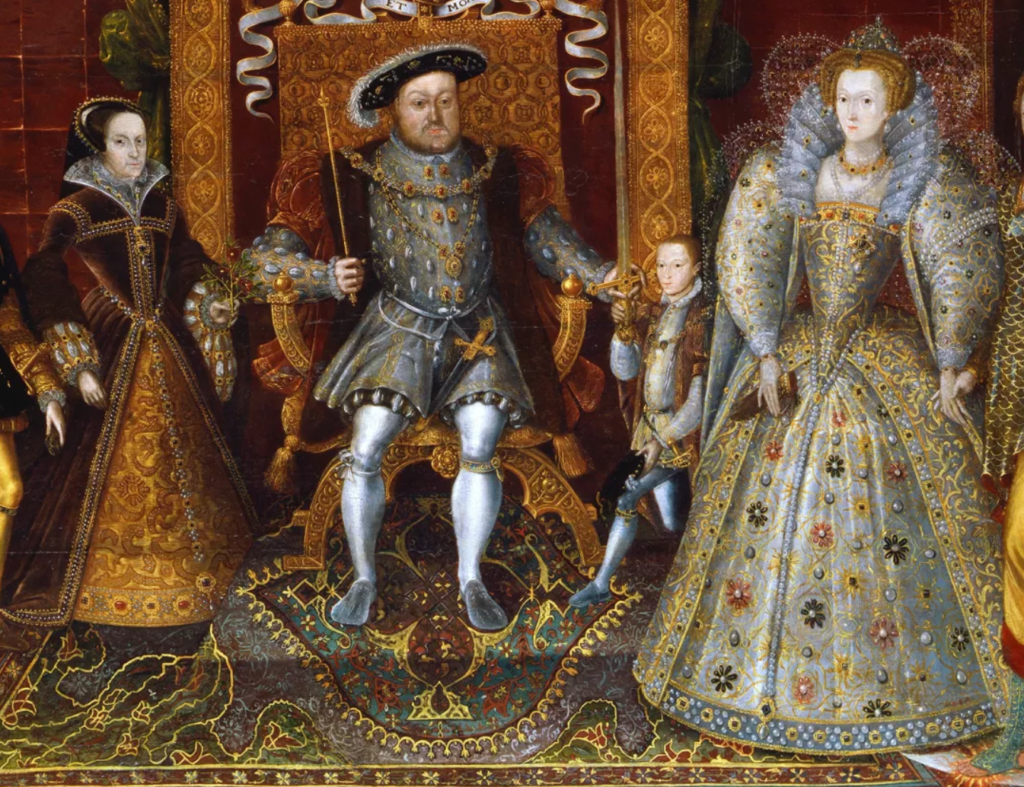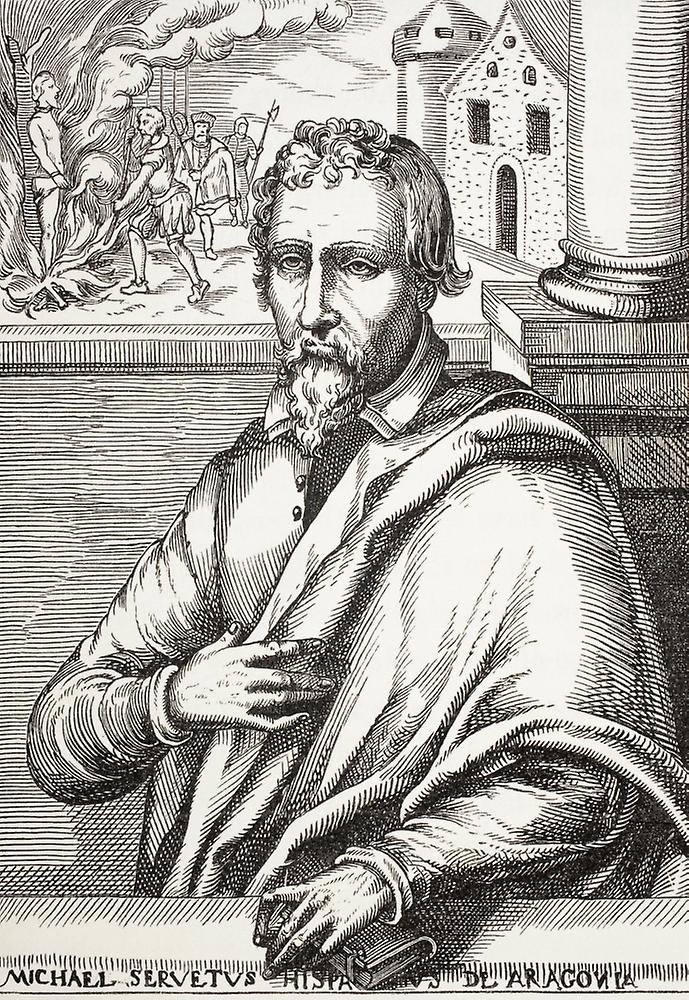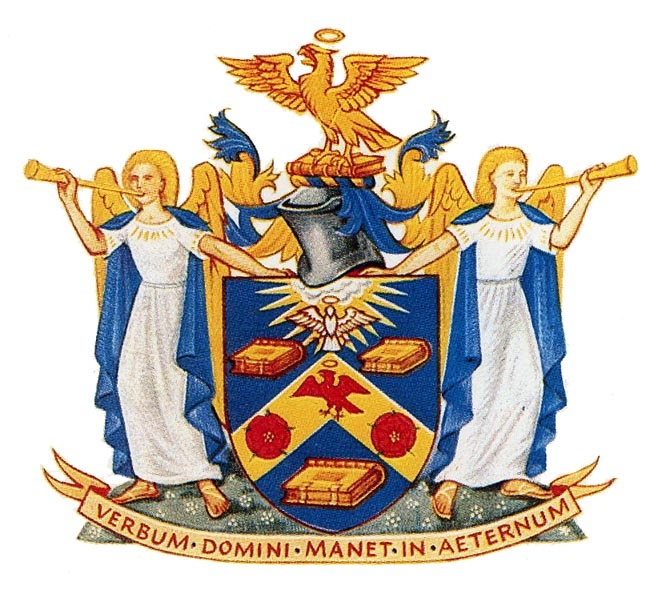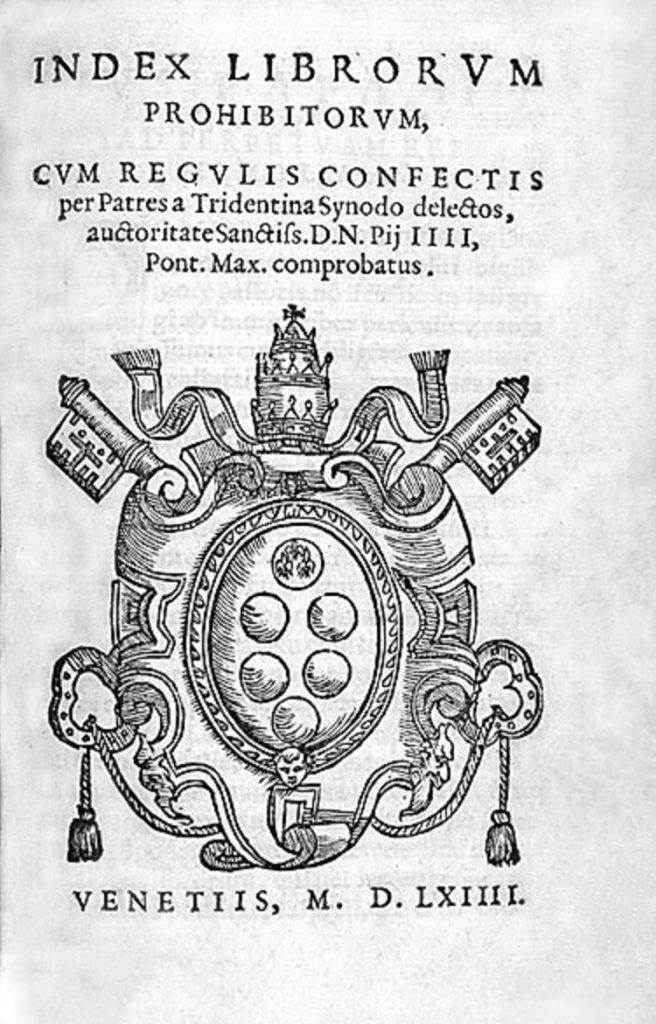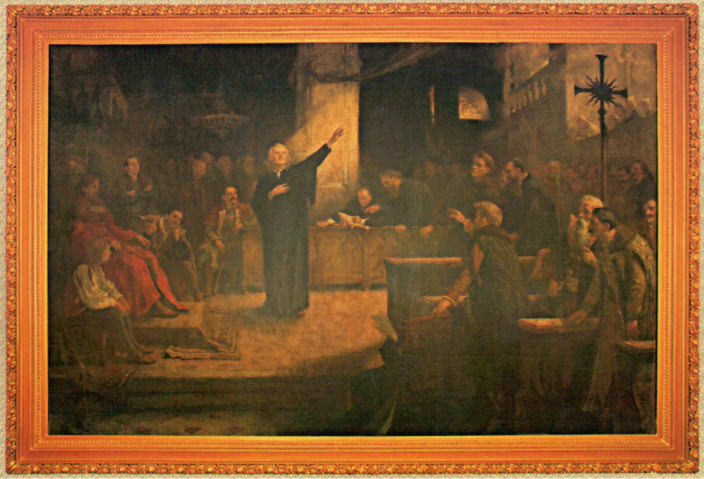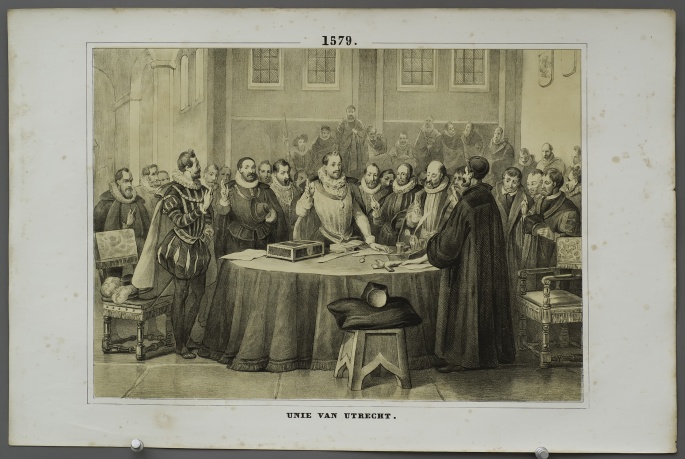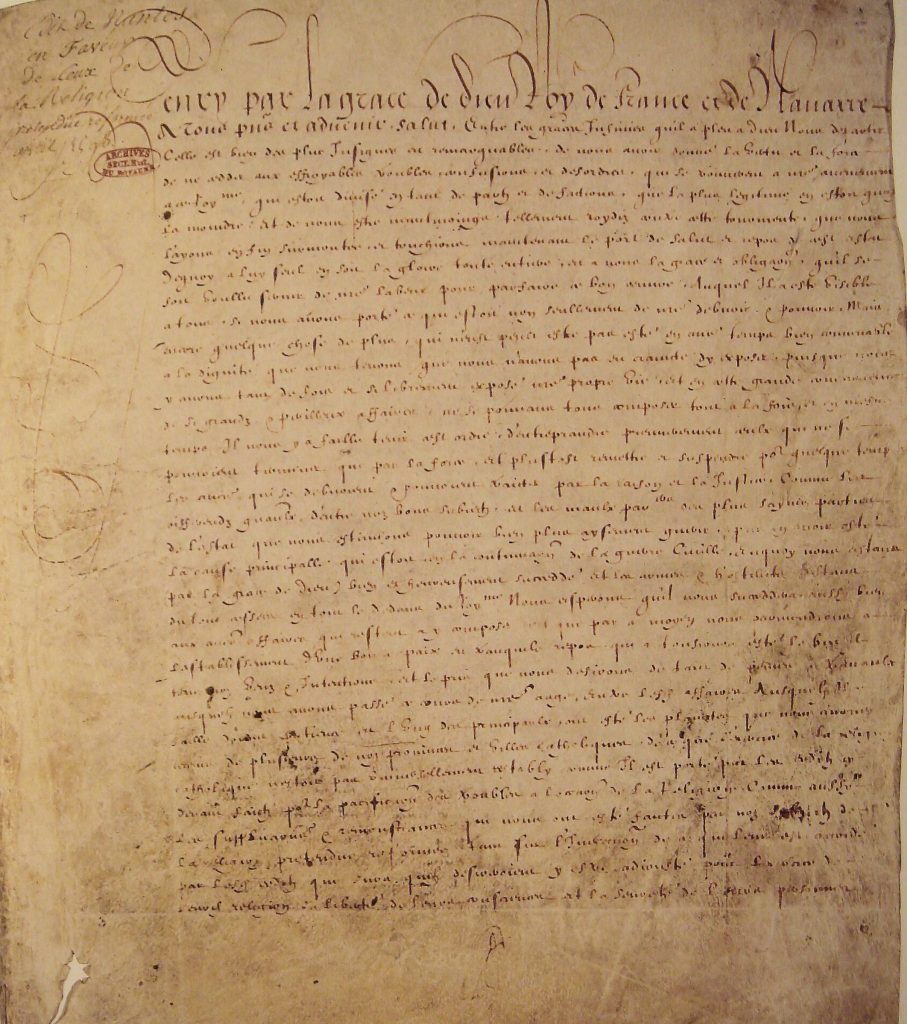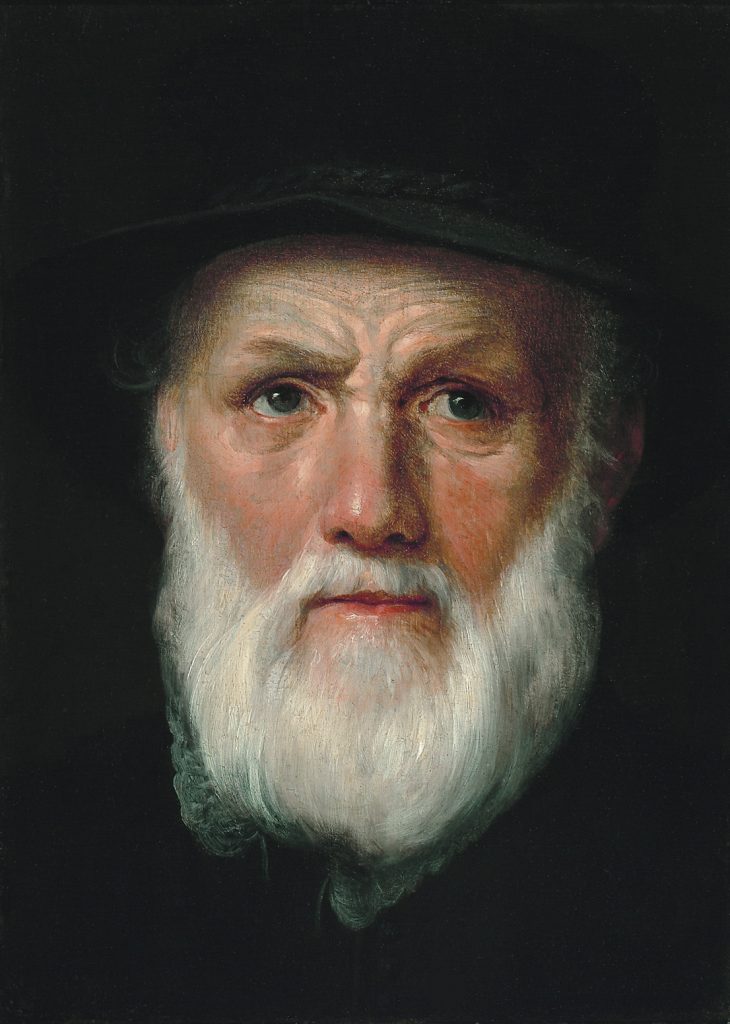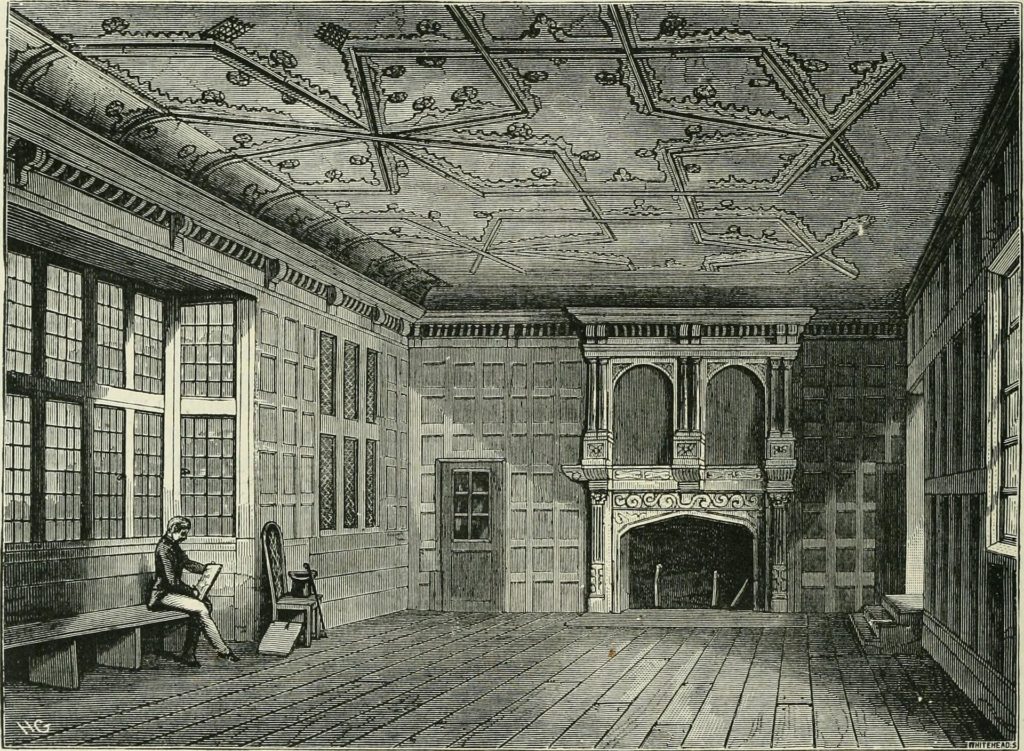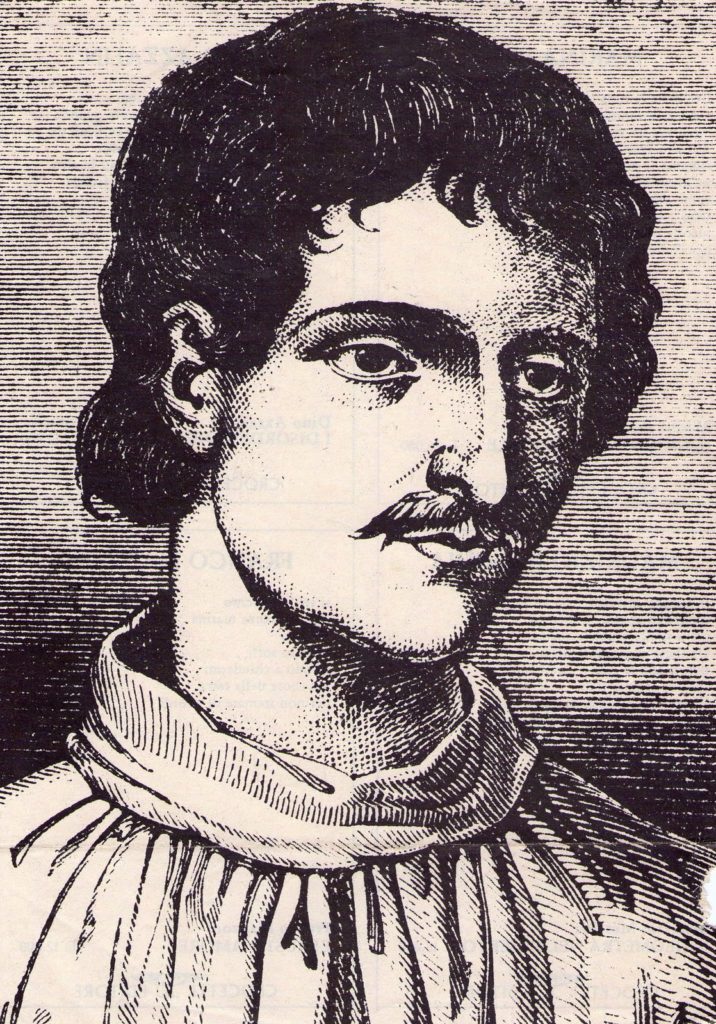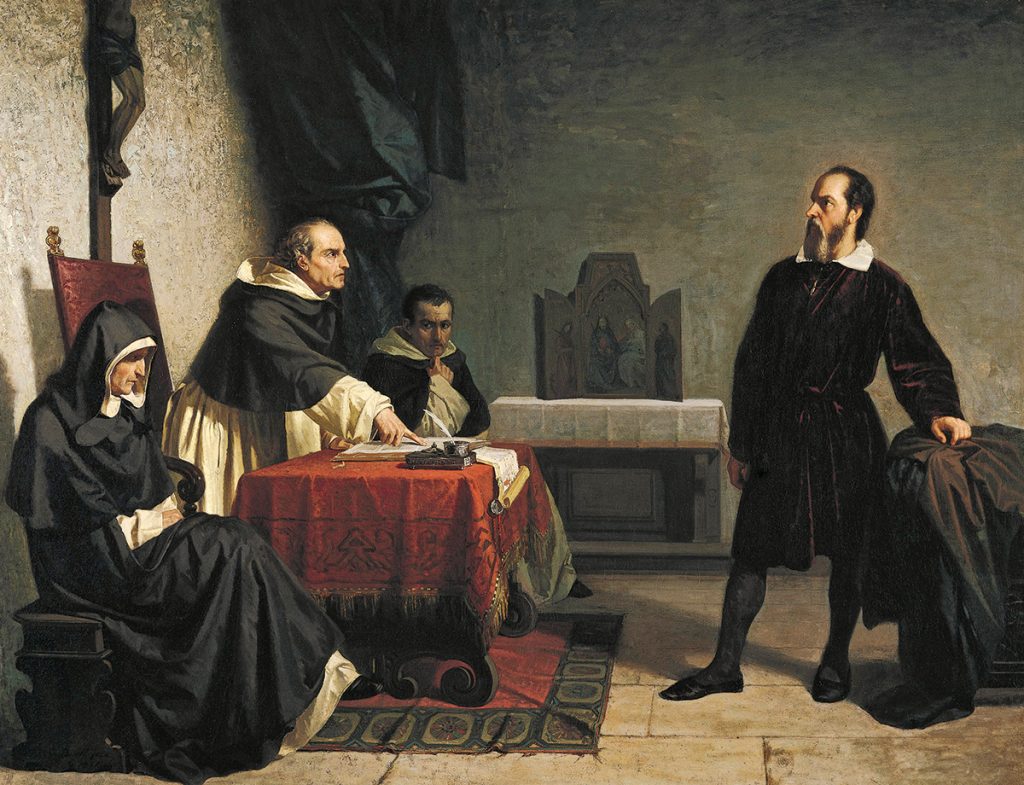FREE SPEECH HISTORY TIMELINE
Dive into a timeline covering the subjects of Clear and Present Danger. The timeline will expand as we travel through the history of free speech.
Free speech history

1517: Luther and the Reformation
Luther at the Diet of Worms in 1521. Anton von Werner, 1877
Martin Luther is the first person to see his ideas go viral with the printing press. In October 1517, he publishes a list of 95 theses criticizing the Catholic church. He reportedly nails a copy to the front door of the church door in Wittenberg – the 16th century Twitter feed. Luther goes viral and sells more than 300,000 books before 1520.
In 1521, the Pope and the Holy Roman Emperor Charles V both try to stop the viral reformation in its tracks. The Pope excommunicates Luther, while the Emperor bans the printing, selling, possession and reading of his works. When Charles V orders Luther to recant at the Diet of Worms in April 1521, Luther refuses:
“Unless I am convicted by the testimony of scripture or plain reason…I am bound by the scriptures I have quoted, and my conscience is captive to the Word of God. I neither can nor will revoke anything, for it is neither safe nor honest to act against one’s conscience. Amen”
– Luther at the Diet of Worms, 1521
The Emperor’s brother, King Ferdinand, bans Protestant literature and preaching in Austria, Bohemia and Hungary.
1529: The Diet of Speyer
The Diet of Speyer in 1529 introduces pre-publication censorship everywhere in the Holy Roman Empire. Every text now has to be approved by an official censor before it can be printed.
1521- : Cartoon wars
The pope’s birth according to an anti-Catholic pamphlet from 1545 (Public Domain)
Thanks to the printing press, the confessional wars of the Reformation become the first testing ground for political and religious memes. Europe is awash with cartoons of ridicule and (literal) demonisation. Here are a couple of examples.
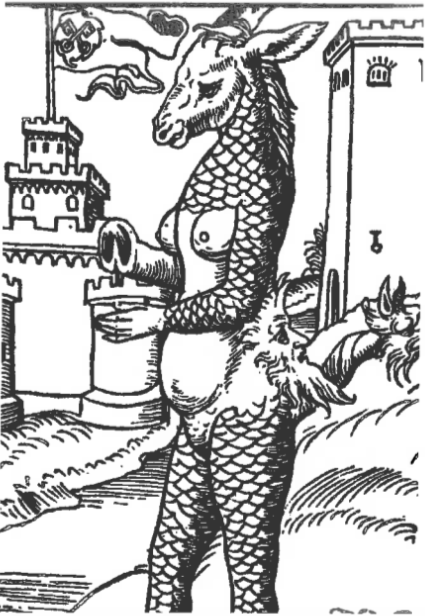
The pope is depicted as a donkey with scales and breasts. The flag in the background shows the papal coat of arms (Public Domain)
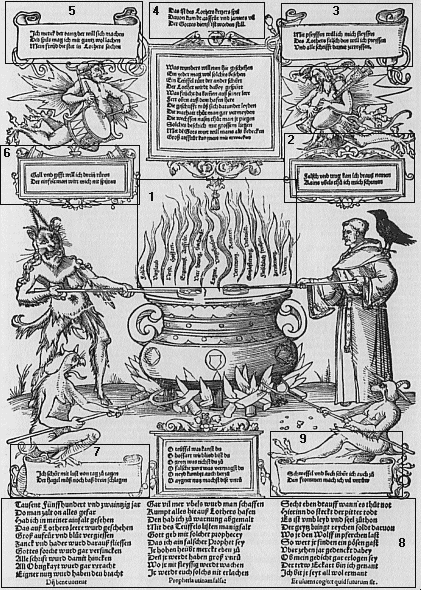
Luther helps the devil stir the cauldron of heresy
1517-1531: Machiavelli’s Discourses on Livy
The political thinker Niccolo Machiavelli makes a sweeping defense of republican liberty and public speech in his Discourses on Livy from around 1517. The book is published posthumously in 1531.
”…a people is more prudent, more stable, and of better judgment than a prince… as to the justice of their opinions on public affairs, [we] seldom find that after hearing two speakers of equal ability urging them in opposite directions, they do not adopt the sounder view, or are unable to decide on the truth of what they hear.
…
The prejudice which is entertained against the people arises from this, that any man may speak ill of them openly and fearlessly, even when the government is in their hands; whereas princes are always spoken of with a thousand reserves and a constant eye to consequences.”
– Machiavelli, Discourses on Livy, ch. 58
Read the full book here.
c. 1560: Witch hunts
Witch-burning in Saxony-Anhalt, 1555. Woodcut after original leaflet, Germanisches Nationalmusem in Nuremberg (Public Domain)
In the late 1500s, Europe is gripped with witch hysteria. An estimated 100,000 are accused. 40,000 are tortured and killed, acording to a conservative estimate.
The witch fever seems to follow the advent of print. Many of the world’s first best-sellers deal with witchcraft, demonology and witch hunting. The best selling book after the Bible is the ‘Hammer of Witches’ from 1487.
Episode XI: The Great Disruption Part II
In episode XI we continue to survey the wreckage after hurricane Luther was unleashed on Europe with the Reformation, with a superstar cast including Calvin, Servetus, Castillio, Acontius, Henry VIII, Bloody Mary, Pope Paul IV, Giordano Bruno, Galileo and many more.
When the Reformation mutated and spread across the continent a burning question arose: Can people of different faiths live together in the same state? Should social peace be based on tolerance or intolerance? We look into questions such as:
- How did other Protestant reformers like Calvin and Zwingli react to religious dissent?
- In what manner did English and continental censorship laws differ?
- How did the Catholic Church react to the Reformation?
- Which states were the first state to formalize religious tolerance?
- How did the scientific and philosophical ideas of Galileo and Giordano Bruno conflict with the religious monopoly on truth and what where the repercussions?
1509-1603: The Tudors
Henry VIII and his children (Royal Museums Greenwich)
The Tudors of England react to the printing press with censorship and crack down on libellers and freethinkers with harsh punishments.
Henry VIII (r. 1509-1547) issues a list of proscribed books in 1529. He also declares it an act of treason to call him a ‘tyrant’ and a ‘heretic’. In the 1530s, the cuts England from the Catholic church and initiates the English Reformation to devorce his wife.
Henry’s daughter, Mary I (r. 1553-58) issues a revised list of proscribed books and punishes slanderous writings with hand amputations. She tries to make England Catholic again and burns around 300 heretics at the stake. This earns her the nickname ‘Bloody Mary’.
Henry’s second daughter, Elizabeth I (r. 1558-1603), finishes the Reformation and declares England a Protestant state. She makes it illegal to skip church and declares it an act of treason to call her a ‘bastard’ and a ‘usurper’.
1553: The execution of Miguel Serveto
Copper engraving of Serveto and his execution by Christian Fritzsch, c. 1740
The Spanish theologian and polymath Miguel Serveto is burned alive in Calvins’s Geneva in October 1553. Because of his anti-Trinitarian theology, he is found guilty of blasphemy and questioning the divinity of Christ. Calvin attend the trial as star witness.
The execution moves the theologian Sebastian Castellio to advocate for religious tolerance in his book Concerning Heretics:
‘Men are puffed up with knowledge or with a false opinion of knowledge and look down upon others. Pride is followed by cruelty and persecution so that now scarcely anyone is able to endure another who differs at all from him. Although opinions are almost as numerous as men, nevertheless there is hardly any sect which does not condemn all others and desire to reign alone. Hence arise banishment, chains, imprisonments, stakes, and gallows.’
– Sebastian Castellio
1559: The Index of Forbidden Books
Index Librorum Prohibitorum, Venice, 1564 (Public Domain)
Paul IV issues the first papal Index of Forbidden Books in 1559. It bans the entire writings of 550 authors, including Erasmus, Machiavelli and Rabelais. To enforce the censorship, inquisitors scan manuscripts, erase passages with ink and cut out pages. Prohibited books are collected and burnt. The index is not formally abolished before 1966.
1568: The Edict of Torda
The Edict of Torda is one of the first edicts of religious freedom in European history. Issued by the Transylvanian Diet in 1568, it recognises the legal status of Lutherans, Reformed, Catholics, and even the persecuted anti-Trinitarians.
“Ministers should everywhere preach and proclaim [the Gospel] according to their understanding of it, and if their community is willing to accept this, good; if not, however, no one should be compelled by force if their spirit is not at peace, … no one is permitted to threaten imprison or banish anyone because of their teaching, because faith is a gift from God.”
– The Edict of Torda, 1568
Three years later, the edict is expanded with an amendment declaring that:
“the word of God shall be preached freely everywhere. No one, neither preacher nor listener, shall come to harm on account of his confession”.
1572: The St. Bartholomew’s Day Massacre
François Dubois, A masacre de San Bartolomé, painted between 1572-1584 (Public Domain)
On St. Batholomew’s Day in August 1572, royal troops execute the Huguenot leaders attending a wedding in Paris. Mass killings erupt and the violence spreads to the major cities of France. Thousands of Huguenots are killed or mutilated.
1573: The Warsaw Confederation Act
On 28 January 1573, the Sejm of Poland-Lithuania passes the Warsaw Confederation Act. It includes a clause on religious freedom:
“…we mutually promise for ourselves and our successors forever … that we who differ with regard to religion will keep the peace with one another, and will not for a different faith or a change of churches shed blood nor punish one another by confiscation of property, infamy, imprisonment or banishment…”
1579: Birth of the Dutch Republic
The Union of Utrecht in 1579. Illustration by J.H. Eichman & H. Altmann, 1856
The Dutch Republic is born in 1579, when the northern states of the Low Countries rebel against the Spanish Habsburgs. The Dutch Republic becomes the vanguard of the early enlightenment thanks to its comparatively liberal attitudes to freedom of conscience and freedom of speech.
The Union of Utrecht from 1579 – the founding document and de facto constitution of the repubic – declares that:
“… each person shall remain free in his religion and that no one shall be investigated or persecuted because of his religion.”
– The Union of Utrecht, article 13, 1579
But in practice, the document allows the individual provinces to determine the degree of religious freedom they allow for their subjects. The Dutch Reformed Church enjoys a privileged position, Catholicism is officially banned and Lutherans, Mennonites, Anabaptists and Jews suffer various restrictions.
The Dutch Republic is more liberal with regards to censorship and freedom of speech. This liberalism results in a blossoming of print, some of the world’s first newspapers and the appearance of books that are banned everywhere else. René Descartes’ revolutionary Discours de la méthode is published anonymously in Leiden in 1637, and Spinoza’s Tractatus Theologico-Politicus is published anonymously in Amsterdam in 1670.
1598: The Edict of Nantes
Grands Documents de l’Histoire de France, Archives Nationales (Public Domain)
The Protestant Henry of Navarre converts to Catholicism in 1572, after the St. Bartholomew Massacre when he is almost killed at his own wedding. He is proclaimed King Henry IV of France in 1589.
In April 1598, the new king issues the Edict of Nantes, granting freedom of worship to his former co-religionists.
The edict remains in force for 87 years before it is revoked by Louis XIV.
“… we have permitted, and herewith permit, those of the said religion pretended Reformed to live and abide in all the cities and places of this our kingdom and countries of our sway, without being annoyed, molested, or compelled to do anything in the matter of religion contrary to their consciences…” – The Edict of Nantes, April 1598
1582: Dirck Coornhert’s Synod on Freedom of Conscience
Portrait by Cornelis van Haarlem, 1686-88 (Public Domain)
Dirck Coornhert’s Synod on Freedom of Conscience from 1582 is a fictional discussion of free speech and freedom of conscious. The discussion takes place between Calvinists, Lutherans, Catholics and various historical persons.
According to Coornhert, the truth is reached “with God’s word, not with the executioner’s sword”. In Chapter 15, Coornhert’s fictional alter ego, the Remonstrant of Leiden, declares that:
“Freedom has always consisted chiefly in the fact that someone is allowed freely to speak his mind. It has been only the mark of tyranny that one was not allowed to speak his thoughts freely. Therefore it is truly tyrannical to… forbid good books in order to squelch the truth” – the Remonstrant of Leiden aka Dirck Coornhert (1582)
But Coornhert is not an unconditional proponent of free speech. He draws his personal limit at “notorious books” which “incite to sedition”.
1586: The Star Chamber Decree
The Star Chamber Decree is issued in 1586, during the reign of Elizabeth I. The law puts the English print trade under stright regulation and gives the Stationers’ Company extensive measures of control and licensing.
1600: The Execution of Giordano Bruno
The philosopher Giordano Bruno is best known for his revolutionary cosmology. According to Bruno, the Sun is the centre of an infinite universe where creation takes place indefinitely.
In 1600, all of his works are banished to the Pope’s Index of Forbidden Books. On February 7th, Bruno is burned alive at Campo de’ Fiori.
“It is proof of a base and low mind for one to wish to think with the masses or majority, merely because the majority is the majority. Truth does not change because it is, or is not, believed by a majority of the people.”
– Giordano Bruno
1632: Galileo and the Inquisition
Cristiano Banti (1857): Galileo facing the Roman Inquisition (Public Domain)
In 1632, the astronomer Galileo Galilei is arrested by the Roman Inquisition. His recent book Dialogue Concerning the Two Chief World Systems promotes the heliocentric worldview and depicts the Pope as a doofus. The inquisitors force Galileo to recant and live out the rest of his life in house arrest. When told to recant his theory of the moving Earth, he allegedly gives the laconic remark:
“And yet it moves.”
– Galileo
